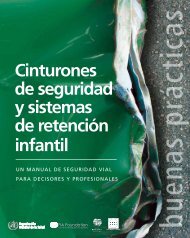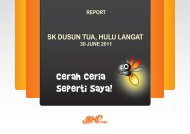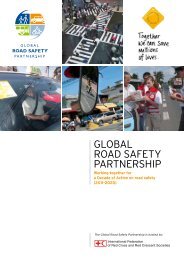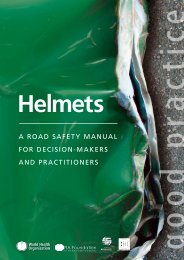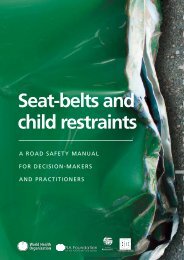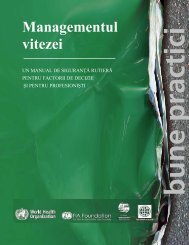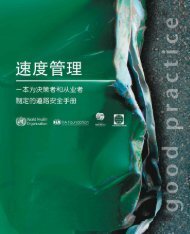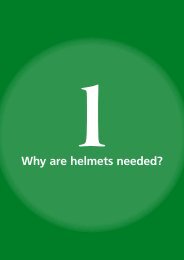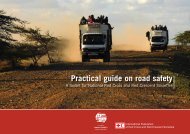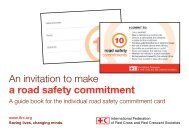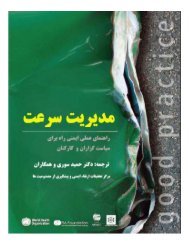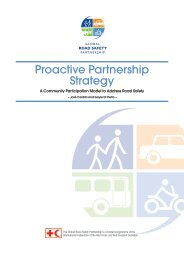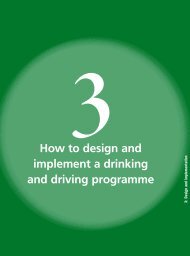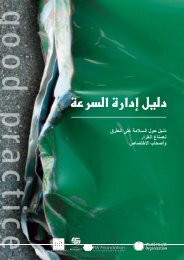How to evaluate the programme - World Health Organization
How to evaluate the programme - World Health Organization
How to evaluate the programme - World Health Organization
Create successful ePaper yourself
Turn your PDF publications into a flip-book with our unique Google optimized e-Paper software.
Helmets: a road safety manual<br />
require significant resources and may be difficult <strong>to</strong> conduct with a limited budget.<br />
There may also be ethical considerations in randomising an intervention with known<br />
benefits (that is, in denying an effective intervention <strong>to</strong> those participants who will<br />
be in <strong>the</strong> non-intervention group).<br />
It is important <strong>to</strong> note that <strong>the</strong>re is no need <strong>to</strong> conduct a randomised controlled trial<br />
on <strong>the</strong> effectiveness of helmets <strong>the</strong>mselves as part of your helmet <strong>programme</strong>. There<br />
is sufficient evidence from a number of studies that clearly demonstrate that helmets<br />
are effective at reducing <strong>the</strong> head injuries and fatalities that result during mo<strong>to</strong>rcycle<br />
crashes (see Module 1).<br />
4 | <strong>How</strong> <strong>to</strong> <strong>evaluate</strong> <strong>the</strong> <strong>programme</strong><br />
Evaluation using a randomised controlled trial<br />
A randomized control trial was conducted in 27 schools in Western Australia <strong>to</strong><br />
assess <strong>the</strong> effectiveness of a whole-school intervention <strong>to</strong> increase <strong>the</strong> correct<br />
wearing of bicycle helmets by primary school children (5). Schools were randomly<br />
allocated <strong>to</strong> ei<strong>the</strong>r intervention or control conditions; <strong>the</strong> main component of<br />
<strong>the</strong> <strong>programme</strong> was peer-led classroom curriculum for 10–12 year old children.<br />
Helmet use was observed at baseline, and at one and two years following <strong>the</strong><br />
intervention. Observed wearing rates declined by 13% in <strong>the</strong> control group<br />
compared <strong>to</strong> 5% in <strong>the</strong> intervention group (p=0.185), suggesting that while<br />
school-based activities may not increase helmet use, <strong>the</strong>y may arrest <strong>the</strong> rate<br />
of decline in helmet use in children.<br />
Quasi experimental designs<br />
These study designs, while not as rigorous as randomised trials, if well conducted,<br />
may also be used <strong>to</strong> establish <strong>the</strong> effectiveness of an intervention. That is, using <strong>the</strong><br />
information collected on trends of <strong>the</strong> indica<strong>to</strong>rs measured, <strong>the</strong>se studies allow<br />
conclusions <strong>to</strong> be drawn as <strong>to</strong> whe<strong>the</strong>r or not <strong>the</strong> intervention (<strong>the</strong> <strong>programme</strong>) is<br />
associated with change in <strong>the</strong> outcome.<br />
Controlled before-after study<br />
This is often <strong>the</strong> most practical design for <strong>programme</strong> evaluation. Randomisation<br />
is not always feasible, for example where some areas have already adopted an<br />
intervention. The controlled before–after study design involves observing <strong>the</strong><br />
outcome of interest (e.g. helmet-wearing rates) before and after <strong>the</strong> <strong>programme</strong><br />
in both <strong>the</strong> people who receive <strong>the</strong> <strong>programme</strong>, and those in a control group. The<br />
control group should be as similar as possible <strong>to</strong> <strong>the</strong> <strong>programme</strong> group and any<br />
important differences between <strong>the</strong> groups need <strong>to</strong> be take in<strong>to</strong> account. Having a<br />
129



